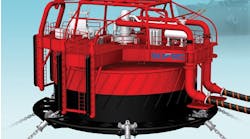Electromechanical system design critical in oil and gas production
Sal Spada
ARC Advisory Group
The often extreme environmental conditions surrounding energy exploration and production push the envelope of electromechanical equipment design specifications. Engineers that design and develop electromechanical tools for these extremes have evolved into a unique breed of specialists.
Conventional engineering design and simulation are integral to analysis and design. However, these tools are only as good as the data used to model the physical behaviors of the materials. Knowledge of the physical parameters and dynamic models of materials subjected to extreme temperatures is a key differentiator for engineering organizations serving this sector.
Drilling wells for light and heavy crudes and tar sands requires ruggedized instruments and actuators that can survive a combination of high temperatures, high pressures, gases, fluids, and steam that are outside of the normal industrial equipment ranges. In addition, of course, offshore projects add the challenge of corrosive seawater.
Capabilities integrated into intelligent downhole drilling tools have revolutionized oil exploration. Electromechanical downhole tools can perform a range of functions including real-time data sensing, active directional control, and plug setting.
Innovations in intelligent electromechanical actuators for downhole use have improved drilling techniques radically by combining remote navigational control for drills located miles deep in the borehole, while obtaining downhole sensory data in real time. Intelligent drilling tools help minimize many risks associated with deep drilling while increasing productivity and reducing human labor requirements.
Today's advanced drilling systems use electromechanical directional steering systems to guide hydraulically powered drills. While many drilling operations still use hydraulic steering, increasing numbers exploit the benefits of an intelligent electromechanical actuator to enable directional drilling. The most advanced downhole directional steering systems are integrated electromechanical assemblies that employ custom-engineered brushless servomotors and electronic subassemblies housed in sealed enclosures.
Over the years, owner-operators, service providers, and equipment suppliers have developed specialized solutions to solve some of the data communications, electrical power supply, actuator control, and data communications challenges are unique to upstream oil and gas.
Data communications can use signals generated by pulses in the mud inside the well pipe. Mud-driven alternators and turbines supply power to electrically actuated rotary steerable drill heads. In some cases, completion actuation tools use miles of wire for power and communications. However, electrical current passed over miles of wire and the associated electrical resistance results in unacceptable voltage drops. This is where mechatronic design experience can be invaluable.
Equipment reliability is also critical to the economics of the drilling operations. The high downtime cost places even greater challenges on designers of intelligent electromechanical systems that must analyze the behavior of the system in this rigorous environment while also packaging the solution to prevent contamination of sensitive electronics and mechanics.
These design applications require specialized, often-proprietary, software that combines physics-based models, empirical data collected over decades of experience, and also factors in harsh ambient conditions. The empirical knowledge accrued from field-experience allows more accurate mathematical modeling to simulate mechanical, magnetic, and thermal behaviors. Often, these are not available in published specifications for many materials. Experience is a key to minimizing the risk in a mechatronic actuator use. Designers must know how to both design the solution properly and package the integrated system to survive for extended periods in extreme environments.
Designing electrical equipment that survives these conditions and also accommodates the limitations imposed on the size and shape of the tool requires an engineered, application-specific solution. Here, a system engineering approach can be beneficial. Manufacturers of intelligent drilling systems often do not have in-house resources and expertise to design servomotors, the associated electronics, and mechanical gearing and power screws (ball/roller) to meet both the environmental and regulatory requirements for the particular application.
In response, a handful of specialized suppliers have developed the ability to deliver cost-effective, engineered solutions for challenging downhole applications. By developing an enabling toolset, the benefits of holistic system engineering can be made commercially viable. One of these vendors has a custom software-based modeling tool that incorporates the knowledge acquired in materials, electrical properties, magnetic properties, and thermal proper properties to help designers do custom engineering. Variables such as the temperature, voltage, and thermal coefficients can be modified to evaluate the materials used to design servomotors and drives.
Practical engineering design tools such as thermal analysis, finite element analysis (FEA), and mechanical computer-aided design (MCAD) are used pervasively. Assuming robust mathematical models exist, these powerful tools can help engineers model the electromechanical dynamics throughout the temperature range of -40°C to 240°C (-40ºF to 465ºF). Mathematical physical models for materials and model parameters in extreme temperature ranges typically test the expertise of engineering organizations. Engineering analysis of dynamic systems requires extra effort because component and material manufacturers often do not publish specifications for these temperature ranges. This requires collective knowledge for these environmental conditions to efficiently determine model parameters to drive these design tools.
Electro-mechanical actuators (EMA) typically require specialized materials to achieve the design goals. Highly energy dense magnets, for example, are critical to reducing motor size but still provide required torque. Off-the-shelf magnets typically cannot meet these requirements. This means designers must work with magnet suppliers using mathematical models of the materials to produce custom magnets that fit a unique set of specifications.
The emphasis for downhole EMA products is on ruggedness and reliability. One solution is an extra-rugged feedback sensor. However, a sensor-less solution eliminates a potential source of failure and may be an acceptable alternative. Since commercially available resolvers and associated resolver-to-digital converters (RDC) often do not meet the high-temperature specifications, they must be custom designed, manufactured, and then integrated directly on the servo amplifier.
Finally, the temperature extremes exceed typical industrial specifications for printed circuit boards, semiconductor devices, and solder compounds. The power amplifier and associated electronics require specialized materials and manufacturing to deliver a high-reliability solution.
The ability to put electromechanical systems downhole, whether in the sub-zero temperatures of the Arctic or the sweltering heat of the Middle East, has changed the economics of drilling and production. Producers depend upon instrumentation and downhole intelligence. As the search for resources ventures into ever-more-hostile environments, intelligent actuators will be at the forefront.
The author
Sal Spada is Research Director at ARC Advisory Group. He has over 15 years of experience in motion control system design as a software developer, project manager, and product marketing manager.


